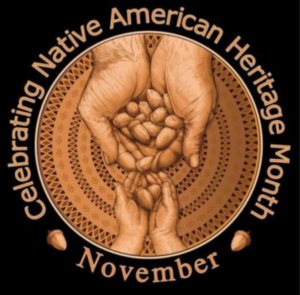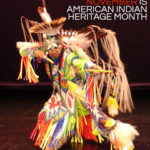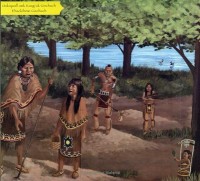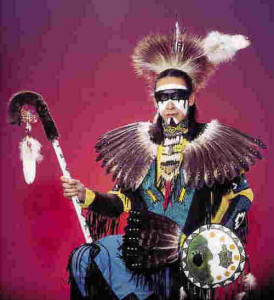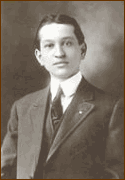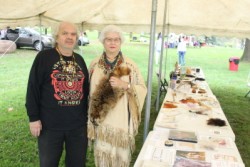
Celebrate November ~ Celebrate Native American Indian Heritage Month and Native American Heritage Day! Remember our Native American Veterans, too! (See Military & Women’s pages)
When the Shadbush Blooms will be featured in The Eric Carle Museum of Picture Book Art. The exhibition is entitled: “Entwined Memory: Indigenous Stories of Creation, Place, and Continuity.” August 4th and on view through December 27th, 2025. So please stop by!
November 2024 National Native American Heritage Month Native Pride and Resilience “Indigenous peoples have the right to the dignity and diversity of their cultures, traditions, histories, and aspirations, which shall be appropriately reflected in education and public information.” ~ (Article 15) U.S. Declaration on the Rights of Indigenous Peoples
A sample of our programs – How Native Americans Saved Football! Penn’s Woods: The Peaceable Kingdom. Native Americans: Keepers of the Land and Water. Native Americans NOW! See our Programs Page for more information.
Our award-winning children’s book When the Shadbush Blooms can be purchased signed & dedicated from our Book for Sale page in the Shadbush section. Schools can purchase our books in bulk from Lee & Low!
The Friday After Thanksgiving Is Designated as a Federal Day of Tribute! The Federal Holiday you did NOT know existed! Most people call it Black Friday.
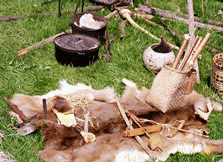 How do you Celebrate the Culture, Contributions & Endurance of your local Native People? How do you show your students that Native Americans are alive and living in your community today?
How do you Celebrate the Culture, Contributions & Endurance of your local Native People? How do you show your students that Native Americans are alive and living in your community today?
http://www.powwows.com/ny-times-conversation-native-americans-race/?utm_source=PowWows.com+Newsletter&utm_campaign=1ca93deed1-EMAIL_CAMPAIGN_2017_08_22&utm_medium=email&utm_term=0_f4c4cee68a-1ca93deed1-53768421&mc_cid=1ca93deed1&mc_eid=6b2ecbb412
1621 A New look at Thanksgiving, National Geographic, Catherine O’Neill Grace & Margaret Bruchac with Plimoth Plantation. GOOD RESOURCE – visuals and descriptions.
Read below the Proclamation for Resources!
During National Native American Heritage Month, we honor the history, rich cultures, and vast contributions of Native peoples. We celebrate the hundreds of Tribal Nations that are ushering in a new era in our Nation-to-Nation relationships. And we recommit to respecting Tribal sovereignty and self-determination and working in partnership with Tribal Nations to bring new prosperity and security to Native peoples.
Indigenous peoples’ history in the United States is defined by strength, survival, and a deep commitment to and pride in their heritage, right to self-governance, and ways of life. Native peoples have built and sustained powerful Tribal Nations, and the knowledge they developed still benefits us today. However, our Nation’s failed policies of the past subjected generations of Native peoples to cruelty, violence, and intimidation. The forced removal of Native peoples from their homes and ancestral homelands; attempts to assimilate entire generations; and stripping of Indigenous peoples of their identities, cultures, and traditions are some of the darkest chapters of our Nation’s history. The trauma and turmoil fundamentally altered their communities. As the first President to visit Indian Country in 10 years, I delivered a national apology for the unspeakable harms caused to Native peoples at Federal Indian Boarding Schools.
Indigenous peoples have persisted and survived — a testament to their resilience and resolve. Today, Native communities are leading the way forward and continuing to strengthen the fabric of the United States. They have long served in the United States military and currently serve in the highest levels of government — including the Secretary of the Interior, Deb Haaland, America’s first Native American Cabinet secretary. In every field and sector, Native peoples are pushing for progress and contributing to our shared prosperity.
Since I came into office, the Federal Government has made record investments in Tribal Nations. Federal contracts with Native American-owned companies increased by over $8 billion from 2020 to 2023. My American Rescue Plan made the largest direct Federal investment in Tribal Nations ever, helping vaccinate Tribal communities during the COVID-19 pandemic and keeping the economy going. My Bipartisan Infrastructure Law made the single biggest investment in Tribal roads, bridges, water, high-speed internet, electricity, irrigation, environmental cleanup, and so much more. My Inflation Reduction Act made the biggest investment in fighting climate change ever — including funding to help Tribal communities lead in the just transition to clean energy and ease the impact of droughts, wildfires, and rising sea levels, which threaten Native lives and precious homelands.
My Administration is also working to ensure that Native communities are safe and secure and have the resources they need to thrive. I signed an Executive Order that improves the Federal response to the epidemic of missing and murdered Indigenous peoples. When we reauthorized the Violence Against Women Act in 2022, we included historic provisions to reaffirm Tribal sovereignty and expand Tribal jurisdiction in cases where outside perpetrators harm members of their Nation. And for the first time ever, my Administration also secured advance funding for the Indian Health Service so hospitals can plan ahead, order supplies, and hire doctors. We have provided historic funding to Tribal communities to help fight the behavioral health crisis and taken significant steps to improve maternal health for Native American women, who are twice as likely to die from pregnancy-related complications as white women.
I have always believed that we must know the good, the bad, and the truth of who we are as a Nation — we must acknowledge our history so that we can begin to remember and heal. That is why I became the first President to issue a formal apology for the Federal Indian Boarding School era, one of the most horrific chapters in our Nation’s history. For 150 years, the Federal Government mandated the removal of Native children from their families and Tribes — and as a result, generations of Native children had their childhoods stolen and whole Tribal cultures were erased. I am proud to formally end the silence surrounding this shameful era and I remain proud that my Administration defended the Indian Child Welfare Act in court, ensuring that our Nation respects Tribal sovereignty and protects Native children by helping Native families stay together and grow up with their languages and cultures. And we are working to support Native American families and communities as they heal from the Federal Indian Boarding School era through the Department of the Interior’s Road to Healing initiative and by supporting Native language preservation and public safety initiatives.
My Administration has also worked with Tribal Nations to preserve, protect, and steward important ancestral Tribal lands and waters. Through more than 200 co-stewardship and co-management agreements signed under my leadership, we are working side by side with Tribes to make decisions about how to manage the lands that are most precious to them. And to date, I have protected and conserved more than 45 million acres of our Nation’s lands and waters. That includes the Chumash Heritage National Marine Sanctuary, vast offshore waters off California’s coast and the first sanctuary to be proposed by Indigenous communities. I have also established, expanded, and restored 11 national monuments, many containing sites considered sacred to Tribal Nations — from Bears Ears National Monument, Grand Staircase-Escalante National Monument, and Avi Kwa Ame National Monument to Baaj Nwaavjo I’tah Kukveni-Ancestral Footprints of the Grand Canyon National Monument, Berryessa Snow Mountain National Monument, and others.
During National Native American Heritage Month, we honor the heritage and contributions of Native peoples, and we work tirelessly to build a future grounded in dignity, respect, and partnership. We remain committed to working with Native communities to write a new and better chapter in American history for Tribal Nations — one that honors the solemn promise the United States made to Tribal Nations, fulfills our Federal trust and treaty obligations, and works together to rebuild Tribal economies and institutions.
NOW, THEREFORE, I, JOSEPH R. BIDEN JR., President of the United States of America, by virtue of the authority vested in me by the Constitution and the laws of the United States, do hereby proclaim November 2024 as National Native American Heritage Month. I urge all Americans, as well as their elected representatives at the Federal, State, and local levels, to observe this month with appropriate programs, ceremonies, and activities. Also, I urge all Americans to celebrate November 29, 2024, as Native American Heritage Day.
IN WITNESS WHEREOF, I have hereunto set my hand this thirty-first day of October, in the year of our Lord two thousand twenty-four, and of the Independence of the United States of America the two hundred and forty-ninth. JOSEPH R. BIDEN JR.
A Proclamation on National Native American Heritage Month, 2022
PRESIDENTIAL ACTIONS
During National Native American Heritage Month, we celebrate Indigenous peoples past and present and rededicate ourselves to honoring Tribal sovereignty, promoting Tribal self-determination, and upholding the United States’ solemn trust and treaty responsibilities to Tribal Nations.
America has not always delivered on its promise of equal dignity and respect for Native Americans. For centuries, broken treaties, dispossession of ancestral lands, and policies of assimilation and termination sought to decimate Native populations and their ways of life. But despite this painful history, Indigenous peoples, their governments, and their communities have persevered and flourished. As teachers and scholars, scientists and doctors, writers and artists, business leaders and elected officials, heroes in uniform, and so much more, they have made immeasurable contributions to our country’s progress.
We must do more to ensure that Native Americans have every opportunity to succeed and that their expertise informs our Federal policy-making. That is why my Administration is engaging in meaningful consultation with Tribal leaders, particularly when it comes to treaty rights, reserved rights, management and stewardship of Federal lands, consideration of Indigenous Knowledge, and other policies that affect Native peoples. That is also why I appointed Secretary Deb Haaland to be the first-ever Native American Cabinet Secretary, and why more than 50 Native Americans now serve in significant roles across the executive branch.
Meanwhile, we are creating new jobs in Native American communities and bolstering infrastructure in Tribal areas. My Administration’s American Rescue plan made the largest-ever investment in Indian Country to help Tribal Nations combat the COVID-19 pandemic and to support Tribal economic recovery. My Administration’s Bipartisan Infrastructure Law secured more than $13 billion exclusively for Native communities to deliver high-speed internet to Tribal lands, build safer roads and bridges, modernize sanitation systems, and provide clean drinking water — all while putting people to work. Through the Inflation Reduction Act, we are lowering the price of health care coverage and capping drug costs for Indigenous families. We are empowering Tribes to fight drought, improve fisheries, and transition to clean energy as part of the most significant climate investment this Nation has ever made. Those investments include climate adaptation planning and community-led relocation efforts, funding a Tribal Electrification Program to provide power to unelectrified homes, making Environmental Justice Block Grants available to help alleviate legacy pollution, bolstering conservation programs across the country, and restoring protections for treasured lands that Indigenous peoples have tirelessly stewarded, such as Bears Ears and the Grand Staircase-Escalante National Monument.
We are also helping Native communities heal from intergenerational trauma caused by past policies. Last year, the Department of the Interior launched the Federal Indian Boarding School Initiative to shed light on the harmful history of forced cultural assimilation at these academic institutions. We are investing in Tribal language revitalization, protecting Tribal voting rights, and working with Tribal partners to tackle the crisis of missing or murdered Indigenous people.
As we look ahead, my Administration will continue to write a new and better chapter in the story of our Nation-to-Nation relationships. We will defend Tribal sovereignty, self-government, self-determination, and the homelands of Tribal Nations. We will support Tribal economies, recognizing that Tribal governments provide a vast array of physical infrastructure, social services, and good-paying jobs that benefit their citizens and surrounding communities. We will keep fighting for better health care, childcare, education, and housing in Tribal communities. We will always honor the profound impact Native Americans continue to have in shaping our Nation and bringing us closer to the more perfect Union we know we can and must be.
NOW, THEREFORE, I, JOSEPH R. BIDEN JR., President of the United States of America, by virtue of the authority vested in me by the Constitution and the laws of the United States, do hereby proclaim November 2022 as National Native American Heritage Month. I urge all Americans, as well as their elected representatives at the Federal, State, and local levels, to observe this month with appropriate programs, ceremonies, and activities, and to celebrate November 25, 2022, as Native American Heritage Day.
IN WITNESS WHEREOF, I have hereunto set my hand this thirty-first day of October, in the year of our Lord two thousand twenty-two, and of the Independence of the United States of America the two hundred and forty-seventh.
JOSEPH R. BIDEN JR.
A Proclamation on National Native American Heritage Month, 2021
OCTOBER 29, 2021•PRESIDENTIAL ACTIONS
The United States of America was founded on an idea: that all of us are created equal and deserve equal treatment, equal dignity, and equal opportunity throughout our lives. Throughout our history — though we have always strived to live up to that idea and have never walked away from it — the fact remains that we have fallen short many times. Far too often in our founding era and in the centuries since, the promise of our Nation has been denied to Native Americans who have lived on this land since time immemorial.
Despite a painful history marked by unjust Federal policies of assimilation and termination, American Indian and Alaska Native peoples have persevered. During National Native American Heritage Month, we celebrate the countless contributions of Native peoples past and present, honor the influence they have had on the advancement of our Nation, and recommit ourselves to upholding trust and treaty responsibilities, strengthening Tribal sovereignty, and advancing Tribal self-determination.
The COVID-19 pandemic has highlighted and exacerbated preexisting inequities facing Tribal Nations. Early in the pandemic, reported cases in the Native American community were over 3 times the rate of white Americans; in some States, Native American lives were lost at a rate 5 times their population share. Even as they shouldered a disproportionate burden throughout the pandemic, Tribal Nations have been paragons of resilience, determination, and patriotism — implementing key mitigation strategies like testing and prioritizing the vaccination of Tribal communities at high rates in order to save lives. Through it all, Tribal Nations have effectively utilized the tools of Tribal self-governance to protect and lead their communities, setting a standard for all of our communities to follow.
Our Nation cannot live up to the promise of our founding as long as inequities affecting Native Americans persist. My Administration is committed to advancing equity and opportunity for all American Indians and Alaska Natives and to helping Tribal Nations overcome the challenges that they have faced from the pandemic, climate change, and a lack of sufficient infrastructure in a way that reflects their unique political relationship.
As a starting point, the American Rescue Plan represented the most significant funding legislation for Indian Country in the history of our Nation — the largest single Federal investment in Native communities ever, with $20 billion in direct funding to help Tribal governments combat and emerge from the COVID-19 crisis. Through the Bipartisan Infrastructure Deal and my Build Back Better framework, my Administration is pushing for strong Tribal participation to help build our Nation’s clean energy future, deploy clean water and high-speed internet to every home, and invest in Native American families, businesses, jobs, and communities.
In my first week in office, I also signed a Presidential Memorandum committing my Administration to the fulfillment of our Federal trust and treaty responsibilities, to respect Tribal self-governance, and to conduct regular, meaningful, and robust consultations with Tribal Nations on a broad range of policy issues. Together, we are implementing a whole-of-government approach to empower Tribal Nations in their efforts to achieve political and economic self-sufficiency, advance climate resiliency, and protect their territorial sovereignty. To further elevate the voices of Native Americans in my Administration, I restarted the White House Council on Native American Affairs earlier this year. It was among the proudest honors of my life to appoint one of our country’s most remarkable leaders, Deb Haaland of the Pueblo of Laguna, to serve as United States Secretary of the Interior — the first Native American in the history of our Nation to serve in the Cabinet.
During National Native American Heritage Month, we also honor our Native Americans veterans and service members who have courageously served and continue to serve in our Armed Forces — including the brave Native American Code Talkers in World War I and World War II. For over 200 years, Native Americans have defended our country during every major conflict and continue to serve at a higher rate than any other ethnic group in the Nation. Because of their selflessness, every generation of Americans receives the precious gift of liberty — and we owe each of them and their families a debt of gratitude for their sacrifice and dedication.
Native American roots are deeply embedded in this land — a homeland loved, nurtured, strengthened, and fought for with honor and conviction. This month and every month, we honor the precious, strong, and enduring cultures and contributions of all Native Americans and recommit ourselves to fulfilling the full promise of our Nation together.
NOW, THEREFORE, I, JOSEPH R. BIDEN JR., President of the United States of America, by virtue of the authority vested in me by the Constitution and the laws of the United States, do hereby proclaim November 2021 as National Native American Heritage Month. I urge all Americans, as well as their elected representatives at the Federal, State, and local levels, to observe this month with appropriate programs, ceremonies, and activities, and to celebrate November 26, 2021, as Native American Heritage Day.
IN WITNESS WHEREOF, I have hereunto set my hand this twenty-ninth day of October, in the year of our Lord two thousand twenty-one, and of the Independence of the United States of America the two hundred and forty-sixth.
JOSEPH R. BIDEN JR.
President Biden’s Indian Day Proclamation 10/10/21
WASHINGTON (AP) — President Joe Biden on Friday issued the first-ever presidential proclamation of Indigenous Peoples’ Day, lending the most significant boost yet to efforts to refocus the federal holiday celebrating Christopher Columbus toward an appreciation of Native peoples.
The day will be observed on Oct. 11, along with Columbus Day, which is established by Congress.
“For generations, Federal policies systematically sought to assimilate and displace Native people and eradicate Native cultures,” Biden wrote in the Indigenous Peoples’ Day proclamation. “Today, we recognize Indigenous peoples’ resilience and strength as well as the immeasurable positive impact that they have made on every aspect of American society.”
In a separate proclamation on Columbus Day, Biden praised the role of Italian Americans in U.S. society, but also referenced the violence and harm Columbus and other explorers of the age brought about on the Americas.
“Today, we also acknowledge the painful history of wrongs and atrocities that many European explorers inflicted on Tribal Nations and Indigenous communities,” Biden wrote. “It is a measure of our greatness as a Nation that we do not seek to bury these shameful episodes of our past — that we face them honestly, we bring them to the light, and we do all we can to address them.”
This month, let us celebrate the traditions, languages, and stories of Native Americans and ensure their rich histories and contributions can thrive with each passing generation. Let us continue to build on the advancements we have made, because enduring progress will depend on our dedication to honoring our trust and treaty responsibilities. With sustained effort and unwavering optimism, we can ensure a vibrant and resilient Indian Country filled with possibility and prosperity.
NOW, THEREFORE, I, BARACK OBAMA, President of the United States of America, by virtue of the authority vested in me by the Constitution and the laws of the United States, do hereby proclaim November 2016 as National Native American Heritage Month. I call upon all Americans to commemorate this month with appropriate programs and activities, and to celebrate November 25, 2016, as Native American Heritage Day.
IN WITNESS WHEREOF, I have hereunto set my hand this thirty-first day of October, in the year of our Lord two thousand sixteen, and of the Independence of the United States of America the two hundred and forty-first. BARACK OBAMA
The links to the left in the Celebrate November! section will give you background, projects, lesson plans, resources and more! Below you will find the Origins of Native American Indian Heritage Month & Native American Heritage Day!

So, look for: Native Food; Thanksgiving Food; Tidbits – Clothing for Native & Pilgrims; The Wampanoag People – they met the Pilgrims; Background on Thanksgiving & various points of view.
This Month in History – November; Children’s Pages; Teacher/Parent Pages; Activity Page for When the Shadbush Blooms and our free newsletter.
Visit: http://www.tolerance.org/search/apachesolr_search/Native%20American
NATIVE AMERICAN HERITAGE DAY
The Friday After Thanksgiving Will Now Be Designated as Day of Tribute
PRESIDENT BUSH SIGNS BACA BILL CREATING NATIVE AMERICAN HERITAGE DAY 2008
Washington, DC – Earlier this week President Bush signed into law legislation introduced by Congressman Joe Baca (D-Rialto), to designate the Friday after Thanksgiving as Native American Heritage Day. The Native American Heritage Day Bill, H.J. Res. 62, is supported by the National Indian Gaming Association (NIGA) and 184 federally recognized tribes, and designates Friday, November 28, 2008, as a day to pay tribute to Native Americans for their many contributions to the United States.
“I am pleased the President took quick action on signing this legislation, which recognizes the importance of Native Americans to our history and culture,” said Rep. Baca. “It is critical we honor the contributions of Native Americans and ensure all Americans are properly educated on their heritage and many achievements.”
The Native American Heritage Day Bill encourages Americans of all backgrounds to observe Friday, November 28, as Native American Heritage Day, through appropriate ceremonies and activities. It also encourages public elementary and secondary schools to enhance student understanding of Native Americans by providing classroom instruction focusing on their history, achievements, and contributions. As a state Assemblyman, Rep. Baca introduced the legislation that established the fourth Friday of September as Native American Day in California – which became state law in 1998.
H.J. Res. 62 was originally passed by the House of Representatives on November 13, 2007. The bill was passed with technical adjustments by unanimous consent in the U.S. Senate on September 22, 2008. Then, on September 26, 2008, the House of Representatives unanimously voted to pass the legislation again, this time including the adjustments from the Senate. The legislation was signed into public law by the President on October 8, 2008.
“This law will help to preserve the great history and legacy of Native Americans,” added Rep. Baca. “Native Americans and their ancestors have played a vital role in the formation of our nation. They have fought with valor and died in every American war dating back to the Revolutionary War and deserve this special acknowledgement.”
“Since my time in the California State Legislature, I have fought to ensure Native Americans receive the recognition they deserve,” continued Rep. Baca. “After introducing the legislation that established Native American Day in California, I am proud to have introduced and passed the legislation that creates a national day of recognition. I thank my good friend James Ramos, now Chairman of the San Manuel Band of Mission Indians, for standing with me from the beginning on this long journey to ensure the contributions of Native Americans are recognized and appreciated by all.”
President Signs Baca Bill Creating Native American Heritage Day
This is a wonderful thing that has been declared, a National Day to recognize the Tribes.
Colleen F. Cawston, MPA, Director – Indian Policy and Support Services PO Box 45105, Olympia, Wa 98504-5105 cawstcf@dshs.wa.gov 360-902-7816 (office) 360-489-9052 (cell) 360-902-7855 (fax)
From: shayne del cohen [shayne@sprintmail.com] Journal # 1201 10/17/08
![]()
![]() A Brief History of Native American Heritage Month
A Brief History of Native American Heritage Month
Source: U.S. Dept. of the Interior, Bureau of Indian Affairs
What started at the turn of the century as an effort to gain a day of recognition for the significant contributions the first Americans made to the establishment and growth of the U.S., has resulted in a whole month being designated for that purpose. Dr. Arthur C. Parker
Early Proponents
One of the very proponents of an American Indian Day was Dr. Arthur C. Parker, a Seneca Indian, who was the director of the Museum of Arts and Science in Rochester, N.Y. He persuaded the Boy Scouts of American to set aside a day for the “First Americans” and for three years they adopted such a day. In 1915, the annual Congress of the American Indian Association meeting in Lawrence, Kans., formally approved a plan concerning American Indian Day. It directed its president, Rev. Sherman Coolidge, an Arapahoe, to call upon the country to observe such a day. Coolidge issued a proclamation on Sept. 28, 1915, which declared the second Saturday of each May as an American Indian Day and contained the first formal appeal for recognition of Indians as citizens.
The year before this proclamation was issued, Red Fox James, a Blackfoot Indian, rode horseback from state to state seeking approval for a day to honor Indians. On December 14, 1915, he presented the endorsements of 24 state governments at the White House. There is no record, however, of such a national day being proclaimed.
State Celebrations
The first American Indian Day in a state was declared on the second Saturday in May 1916 by the governor of N.Y. Several states celebrate the fourth Friday in September. In Illinois, for example, legislators enacted such a day in 1919. Presently, several states have designated Columbus Day as Native American Day, but it continues to be a day we observe without any recognition as a national legal holiday.
Heritage Months
In 1990 President George H. W. Bush approved a joint resolution designating November 1990 “National American Indian Heritage Month.” Similar proclamations have been issued each year since 1994. The theme for 2004 was “Celebrating our Strengths.”
Information Please® Database, © 2005 Pearson Education, Inc. All rights reserved.
The term “Native American” came into usage in the 1960s to denote American Indians and Alaskan Natives (Indians, Eskimos, and Aleuts of Alaska). There are more than 554 federally recognized Indian tribes and Alaska native groups, each with their own culture and history. They speak more than 250 languages. Web Editors Note: There are many State recognized Native Nations / Groups and many more that are not recognized by their state of origin.
——————————————————————————–

